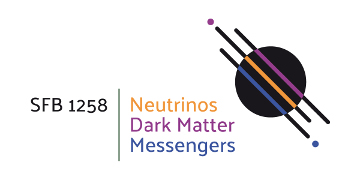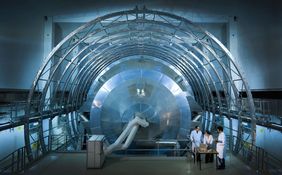For around two decades, it has been known that neutrinos possess an at-rest mass – in contrast to previous assumptions. However, no one can say how much the neutrino actually weighs. That should change with KATRIN.
"Many of the threads of modern physics come together in the neutrino," says Susanne Mertens from the Max Planck Institute for Physics. "Its properties help us to better understand how our world is built – from the smallest building blocks in particle physics to the large-scale structures in space." Together with two other scientists, Mertens coordinates the work of the international analysis team in the KATRIN experiment.
Scientists also associate the “super” particle with the hope of encountering hitherto unknown physics, that is, phenomena that cannot be explained by the long-established Standard Model of particle physics.
Measuring the unmeasurable
The starting point for determining the mass of the neutrino is tritium – a radioactive, heavy variant of hydrogen. The decay of tritium nuclei produces one electron and one neutrino. They share the decay energy of 18,591 electron volts (eV).
This energy is randomly distributed across both particles. "However, we know from Einstein's famous formula, E = mc², that the neutrino, which is not directly observable during decay, must at least retain its at-rest mass – and that mass is then missing from the electron," explains Mertens.
It is precisely this tiny deficiency of no more than 2 eV, corresponding to the unimaginably low mass of 3.6 x 10-37kilograms, that the KATRIN researchers are tracking down with their neutrino scales. They are seeking to measure the maximum energy that the electrons achieve in the beta decay of tritium. To put it simply: if this is subtracted from the decay energy one arrives at the neutrino mass.
Analysis of many billions of decays
To provide statistically significant proof of neutrino mass, enormous volumes of data must be processed. Compared to previous neutrino mass experiments, KATRIN has a source one hundred times more intense: 100 billion tritium decays occur per second.
One electron and one neutrino are created per decay. However, only around one electron per second is relevant to determining the neutrino mass. The scientists will analyze the energy of several billion neutrinos over a period of three years.
Experiment setup
The tritium source consists of a 16-meter-long cryostat which, like all other source components, is set up in the Tritium Laboratory Karlsruhe (TLK). The electrons from the source are steered by strong magnets to the heart of KATRIN, the giant electrostatic spectrometer. It was delivered in 2006, in a <link http: www.katrin.kit.edu internen link im aktuellen>sensational journey from the manufacturer in Bavaria, by ship via the Danube, the Mediterranean and then upriver to KIT.
After many years of planning, setting up and commissioning the major components of the 70-meter-long experimental setup, almost 200 members of the international KATRIN collaboration, from 20 institutions in seven countries, are looking forward to the measurements starting in June 2018.
Related links
<link https: www.kit.edu kit english pi_2018_069_neutrinos-weighed-by-the-world-s-most-precise-scale.php external-link-new-window internen link im aktuellen>Press information of the Karlsruhe Institute of Technology (KIT)
<link http: www.webcast.kit.edu external-link-new-window internen link im aktuellen>Official inauguration of the KATRIN experiment on 11 June 2018, live stream
Contact
<link mail internen link im aktuellen>Prof. Susanne Mertens
Max Planck Institute for Physics
Technical University of Munich
Tel. +49 89 32354-590



